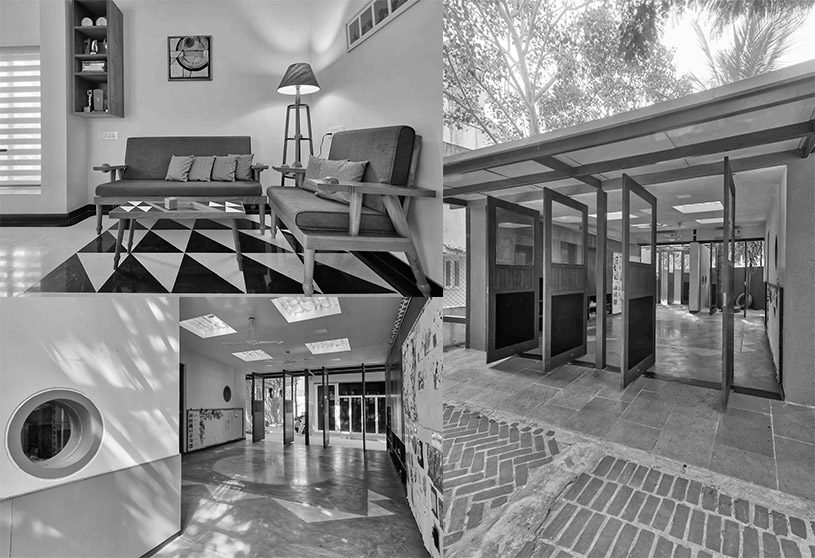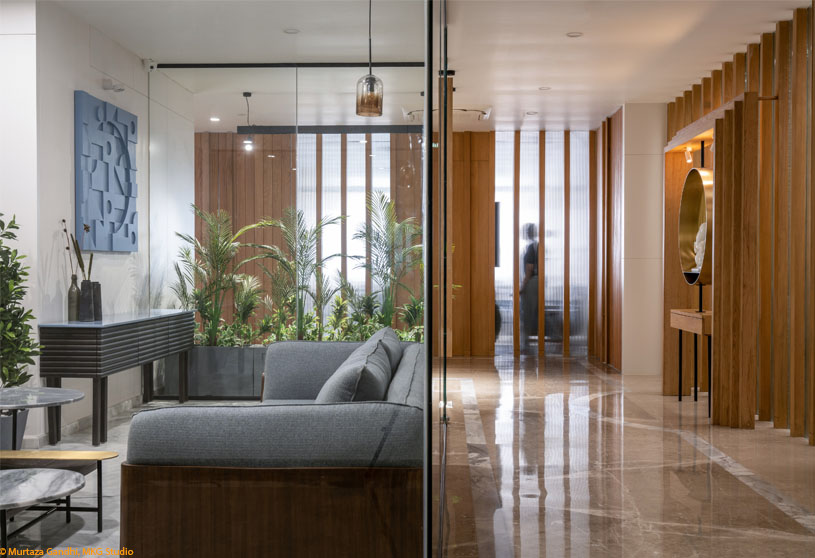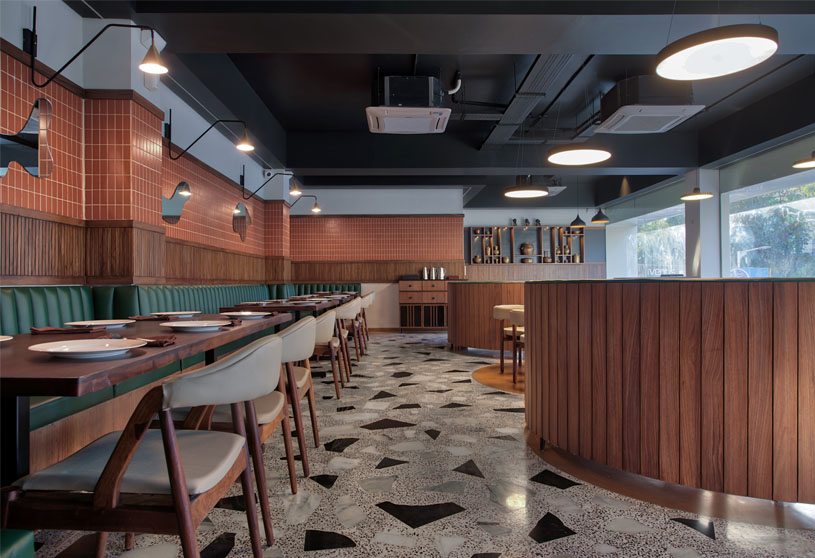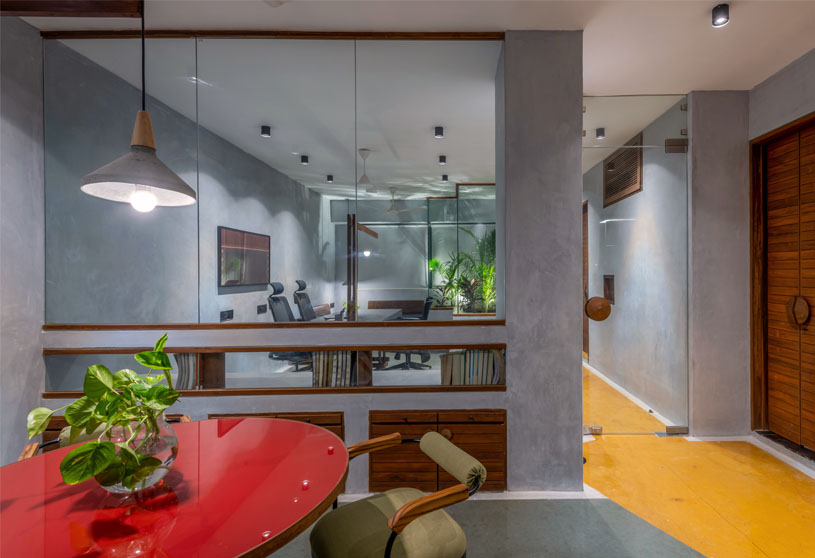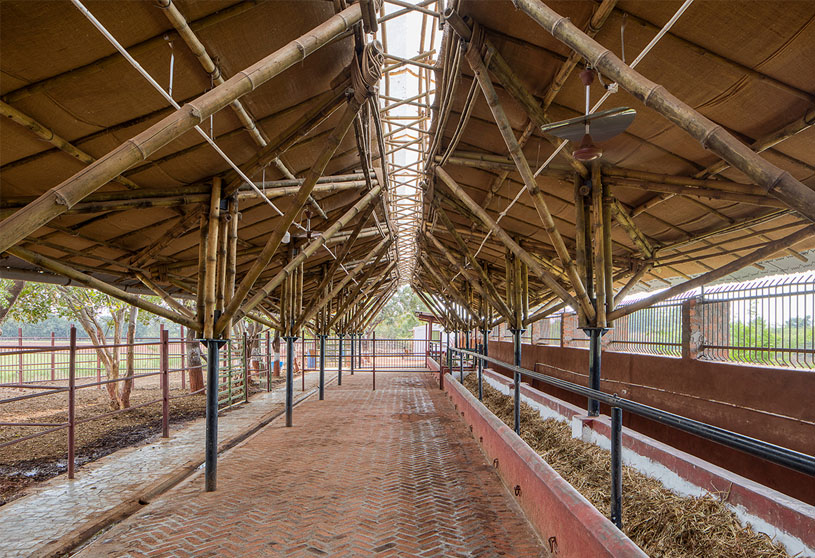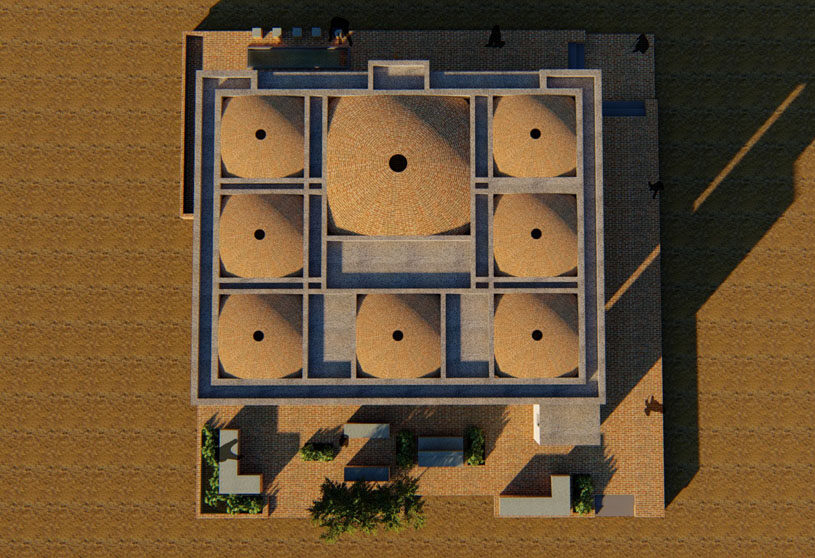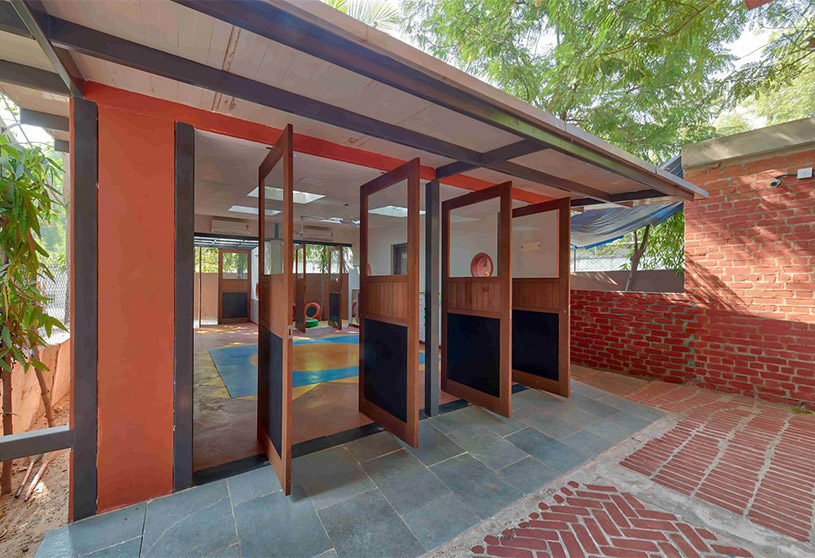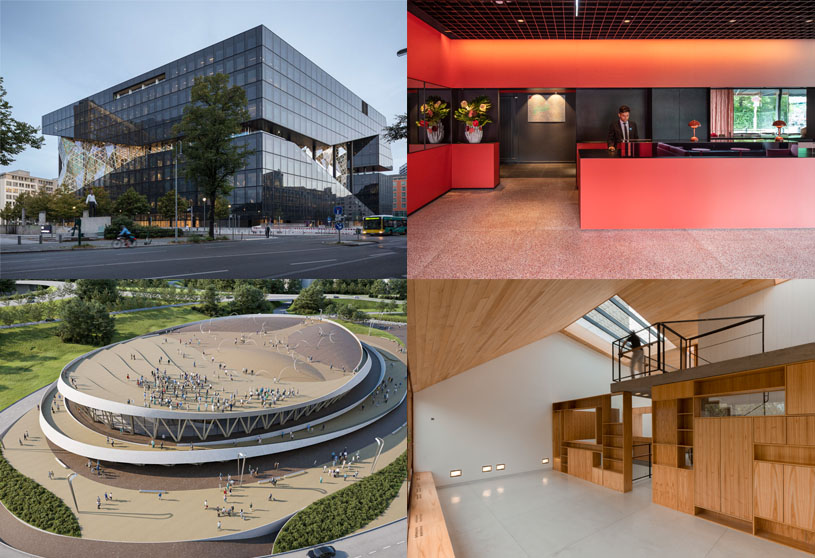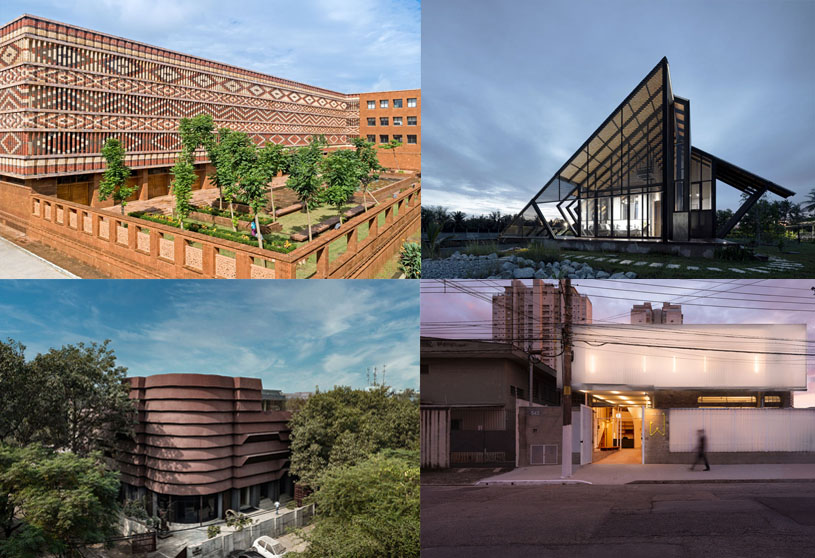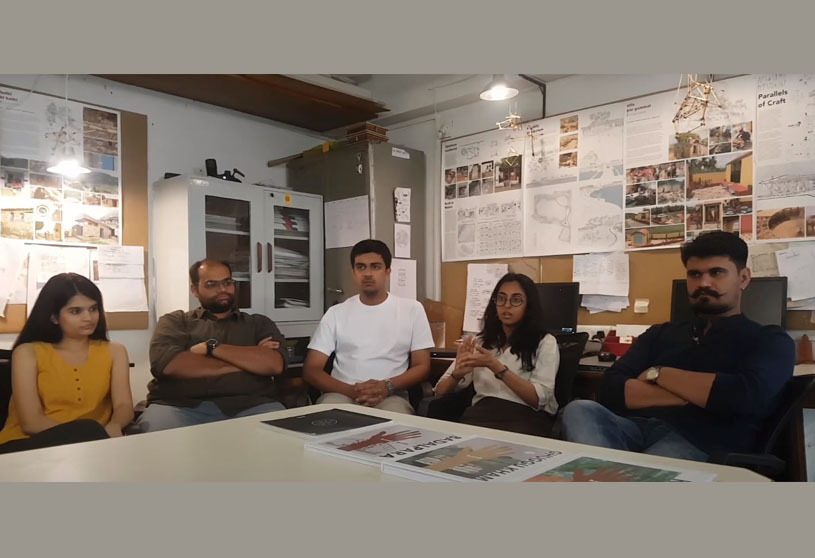(“Text as submitted by architect”)
 Krishna Parikh
Krishna Parikh
With a knack of having ready solutions to anything and everything, she is the one in the group who can set things straight when situations are going astray and at the same time also be the one to slip out of the way when complexities arise. If you can’t find her someday, you would either find her on her bed gobbling on books/netflix or hidden somewhere amidst a lot of plants. An avid reader, a skillful artist, a modest classical singer and with a pitch that can blow off the roof, she is endowed with a lot of talents. During her time in CEPT University, she interned at Palinda Kannagara’s office, which shaped her ideas of how architecture can blur boundaries between the built and the unbuilt and how architecture can intersperse with natural elements to enliven spaces. In her final year at the university, she had proposed a systemic approach of integrating organic farming into the programmatic conceptualisation of a design of an urban school. Later she took this idea further in her research thesis, where she studied the various spatial configurations that emerge in the context of Urban farming, its relationship with other spaces and the associations that people form with it. She is currently pursuing her masters at Cornell University, New York, USA.
 Monik Shah
Monik Shah
With a special ability of finding ingenious solutions to precarious problems and a natural talent for making precise handcut models, he is the one you will find on site hobnobbing with the craftsmen and workers whilst gobbling up food. His first love includes cricket, ‘healthy’ street food, card games, patriotic songs and cheering for India anywhere and everywhere. Trained as an architect from CEPT University, his passion for hands on work grew after his experience of working with bamboo at Indonesian firm Ibuku. Combining his interest in the eco- hospitality sector and travelling to distant untouched places, his final design project nestled in the rainforests of Meghalaya. His further inquiry into rapid urbanization of small town called Sawantwadi, Maharashtra and its architectural consequences as a part of his research thesis has translated into a humane approach to rural development.
 Kishan Shah
Kishan Shah
The go to person for anything related to colours, patterns, textures and design details, he lives in “his own world” of good movies, better illustrations and the “best music”. A skilled sitar player, a vegan baker par excellence, a dedicated tegestologist, he brings his flair and finesse to any project he undertakes, be it a poster or a flooring pattern. His multifaceted interests developed over time with exposure to different design approaches at BSSA, CEPT University and during his training at SDEG Bangalore. His acute sense of observation and awareness for social tensions resulted in a final design project, which combined space making with social upliftment and well being through a public intervention for children of saltmaking communities in rural Kutch. His interest in exploring social relationships of spaces coupled with his love for the city of Bombay, lead him to further explore the relationship between people and elements of street furniture on the public spaces at the waterfronts of Bombay.
 Manuni Patel
Manuni Patel
With an uncanny ability of keeping a track on everyone’s actions, she is Compartment S4’s unofficial manager, making sure that everything is in order and according to her plan. The most mundane things will excite her and the most insignificant occasion calls for a party. A little parcel with an immense amount of energy, twitching to discover new music and make new friends. She’s one who can binge watch Netflix and gobble pizzas for hours at a stretch. Apart from being an efficient designer, she’s the one handling all the money and administrative matters of the office. Her internship with Anil Dube in Bangalore has given her an edge over the others, speedily delivering drawings like hot cakes. In her final year project, she designed a bus terminal in Ahmedabad, in which she tackled issues of creating a functional public space that responds to the immediate context as well as the fabric of the city. In her research thesis, she went on to study built environments in low rise housing and the social interactions that occur as a result of specific design decisions.
 Vedanti Agarwal
Vedanti Agarwal
The thinker and the writer of the group, you will always find her wandering, gathering, arranging and then re-arranging her thoughts in lists, points, questionnaires and essays. She surrounds herself with lots of books, heaps of random papers, tracings, stationery and healthy snacks. An avid reader, who also loves to write about architecture and design in general and enjoys designing intricate jewellery and eating gourmet food. Her internship at Hundred Hands expanded her vision and broadened her perspectives about how an institution is designed. She took these ideas further in her final year project where she was trying to harness the potential of adaptive reuse of an old dilapidated power station in Ahmedabad into a vibrant public space for the city. This deepened her interest in designing programmes and looking at design as a systemic approach and not merely as a derivation of conceptual ideas. Through her research thesis, she studied the relationship between theoretical constructs operating in architecture and their relationship to built expressions. She has been writing for an online publication “Matter”, where she is trying to analyse different modes of architectural practice and its relation to the design process.
 Prasik Chaudhari
Prasik Chaudhari
From perpetually being at the wood workshop and taking ‘chai’ rounds at CEPT to prototyping design now, he has carried forward his love for working with hands. Whether it is model making or building on site, he is the one who can ‘make it happen’. His proactive attitude ensures workings on site are well-managed and seamless. With an ingenious ability to break down any detail to its simplest form of assembly, he is called upon for construction queries every now and then. He did his training at Sen Sen Design, Delhi. His sense of clarity in making with different materials has developed through the many workshops he has assisted and conducted. Even his final year project involving the design of flood resilient structures, was detailed out very meticulously. This seeped into his research thesis as well, where he documented all joineries and details of the old houses of his home town in Patan.
 Aman Amin
Aman Amin
The official organizer of the team, he is called to rescue whenever anything has to be composed, sorted, arranged, catalogued or aligned. His insane ability to imagine any chaotic mess as lines, rows, columns, categories, flowcharts turns banal to beautiful. An architect from CEPT University by profession, a graphic designer by instinct, a film aficionado, a music enthusiast and an amateur chef, he dons many hats at once. His training at Playgroup Studio, Goa evolved his design thinking towards the possibility of a well-articulated spatial experience being a promoter of social change. He took this idea further by researching about the spatial preferences of children in school.
 Nishita Parmar
Nishita Parmar
An artist at heart and a contractor by mind, she is a great balance of an architect at work. With a wonderful drawing hand, she can add life to any and all of our drawings. Her keen interest in acting and comical lens of looking at the world, brings in the breath of lively happenings in any environment. During her education at CEPT university, she interned at Palinda Kannangara’s practice. Her final year project involving the design of a cotton ginning factory has developed her sense of designing through spatial experiences even in mundane contexts, while giving her an expertise to deal with specific functions. For thesis she studied correlations between architectural design and formwork systems for exposed concrete. With a list of contacts up her sleeve, we are never falling short of people needed for work. From plumbers to journalists, we have them all.
